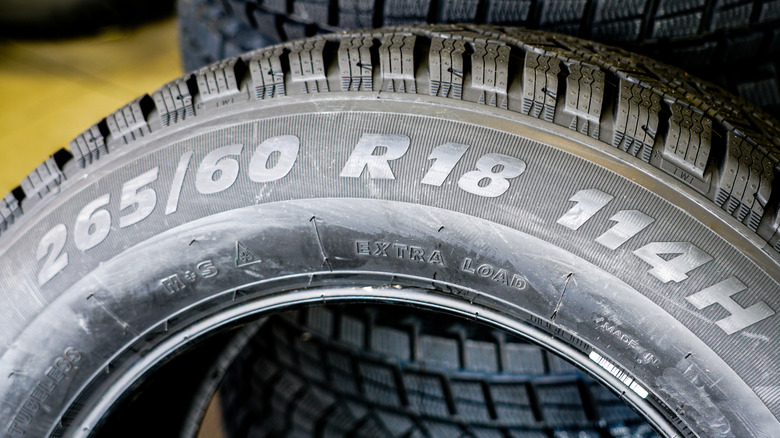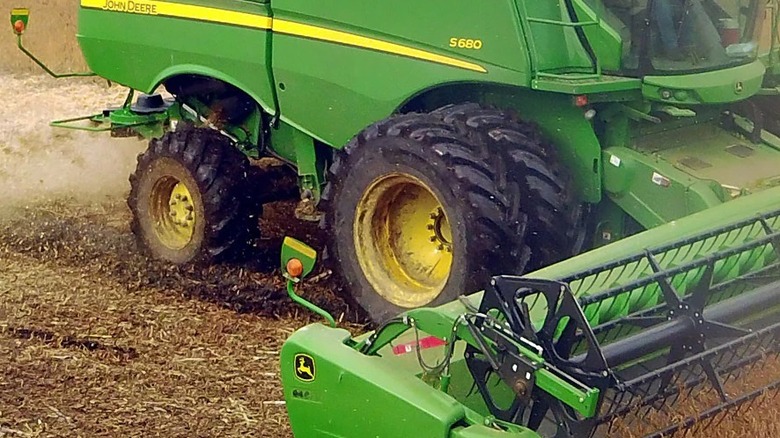How To Know The Top Speed Rating Of A Tire (And What Is The Fastest-Rated One Out There?)
Choosing the right tires is important to getting the most out of your car. Just because tires all look more or less alike doesn't mean they all perform the same, especially when it comes to speed. While some tires are made to withstand the rigors of daily driving, others are specifically designed for the racetrack. One way to tell them apart is using the industry-standard speed rating system. It's important that you know the recommended speed rating for your car's tires when driving or shopping for new rubber.
If you push tires beyond their rated limit, they become vulnerable to wear and damage, and a blowout at high speed can be very dangerous. So if you're headed to one of the states with the most extreme speed limits, make sure to check just how fast you can safely drive on your tires. Thankfully, tire manufacturers encode this information on the sidewalls of tires along with other important information.
How to find the speed rating on tires
Tire speed rating is embossed on the sidewall along with the tire size, load rating, and a manufacturer's date code. Tire size is usually expressed as xxx/yyRzz. The first three numbers indicate the tire's width in millimeters and the yy is its aspect ratio — the height of the sidewall expressed as a percentage of the width. The two-digit number after the R is the wheel diameter in inches. For instance, you might have a 245/45R17 or a 225/70R16. The two or three digits that follow the tire size indicate the tire load index, the weight the tire can handle when fully inflated. Immediately after this is a single letter, which is your tire's speed rating. Common ratings for passenger cars are T, H, and V, and faster tires earn ratings of W, Y, or Z (there is no "X" tire speed rating). You might find speed ratings of L through R on some temporary spare, off-road, or winter tires.
The codes on tires at the faster end of the scale can appear with some variations. Michelin and General Tire place a Z in front of the R in the size code for tires with speed ratings of W or Y, for example 235/40ZR18 instead of just 235/40R18. If you find the letter Z in the tire size and the load index and letter Y in parentheses, that means your tire's top speed rating is (Y), which is a different rating from Y. Unlike for some W and Y tires that may or may not include the letter Z in the code, all manufacturers of (Y)-rated tires are required to include that designation in the tire size. Your (Y)-rated tire might then show 255/35ZR19 (96Y) or something similar on the sidewall.
Tire speed ratings explained
Now that you've found the code designating the speed rating of your tires, how fast can you safely go? Each letter in the tire speed rating chart corresponds to a maximum speed limit. The chart is arranged alphabetically from A to Z, except for H which is unconventionally placed between T and V. A is also subdivided numerically into A1 to A8. Slower limits are earlier in the alphabet, with higher speeds coming further down the scale. A1 tires are limited to just 3 mph, A2 to 6 mph, A3 to 9 mph, and so on. The maximum speeds for more common car and light truck tire speed ratings are as follows:
- T – 118 mph (190 kph)
- H – 130 mph (210 kph)
- V – 149 mph (240 kph)
- W – 168 mph (270 kph)
- Y – 186 mph (300 kph)
The fastest-rated tires out there have the (Y) rating, which is technically one of the three sub-categories of the Z/ZR rating along with W and Y. (Y)-rated tires can support speeds of more than 186 mph (300 kph), with the exact limit determined by the manufacturer.You can usually find this information on a tire's specifications webpage or in the owner's manual you get when you buy them.
You might notice the intervals are oddly spaced on the imperial measurement side but more regular with respect to metric figures. That's because tire speed ratings were first implemented in Europe, where the metric system is used. The speed ratings are placed at five-kph increments for those categories under 50 kph, 10 kph for speeds from 50 to 210 kph, and 30 kph increments beyond 210 kph.
What are low-speed tires used for?
Tires with speed ratings of T and higher are generally installed on road-going passenger vehicles. T and H-rated tires are typically seen on family sedans, minivans, and some SUVs and crossovers. V, W, Y, and (Y) ratings are common among tires for high-performance sports cars and exotic vehicles.
On the other hand, the slower-speed rated tires from A1 to J are primarily used in commercial applications like farming, construction, mining, forestry, and freight handling. For instance, A2 tires are common on wheeled excavators and compactors, and you might see A5 tires on forklifts or reach stackers, Here are some typical applications of other heavy-duty, slow-speed tires:
- A8 – backhoes, tractors, and combine harvesters
- B – road graders and mining equipment like loaders and articulated dump trucks
- D – farm tractors, sprayers, and trailers
- E - Dump trucks and other heavy trucks
- F – cranes
- G – tactical wheeled vehicles and boom forklifts
- J – trailers and electric buses
Although speed ratings cover a broad range, keep in mind that all manufacturers don't make tires of every rating. Among the offerings from the top-rated major tire brands, you will probably find the best selection of tires for your car falls in the T-W range. Also keep in mind that speed rating codes aren't permission to travel at those maximum speeds at all times. Drive according to the posted speed limit and weather and traffic conditions, and under no circumstances exceed the top rated speed of your tires.



